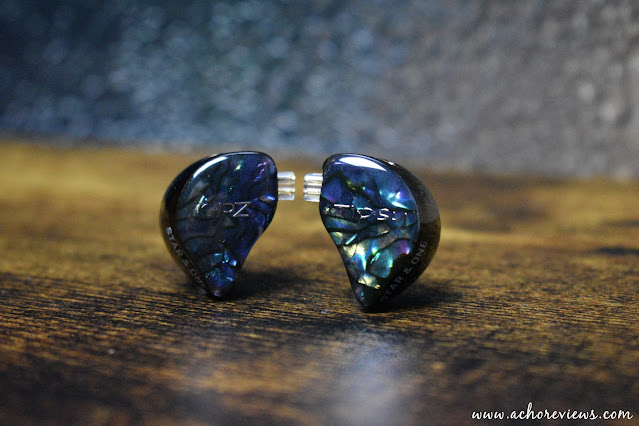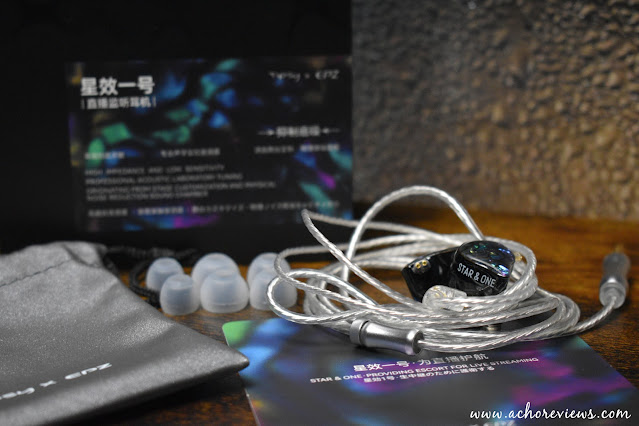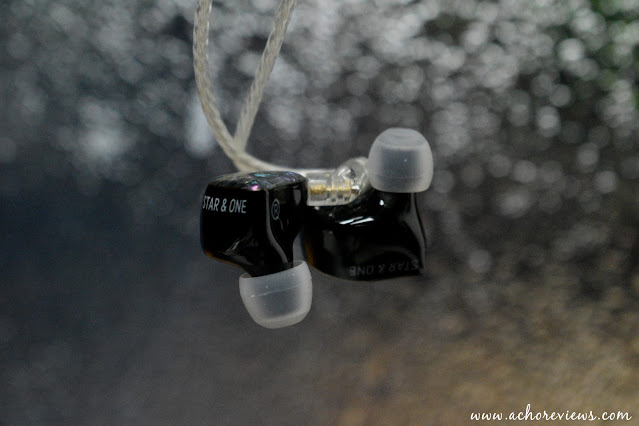- Get link
- X
- Other Apps
English | Español
TLDR version on YouTube: TDLR - Tipsy x EPZ Star & One
Not long ago, I reviewed a couple of sets of IEMs by a brand called EPZ (the Q5 and G10). While I thought they were trying hard, I said that I just wasn’t a fan of the tuning, mainly due to the 5kHz peak.
Rather than getting upset and telling me my opinions are wrong (like some other brands have done in the past), their reply was “Thanks for your honest review. We have a new set, I think you will like these” and proceeded to ship them to me.
That is the only comment that EPZ have made about these IEMs, therefore, as always, I will attempt to be as unbiased as humanly possible in this review.
The IEMs, called the Star & One are actually a collaboration between EPZ and Tipsy, another brand that I have reviewed in the past, and can be found on the EPZ Aliexpress store here: Star & One EPZ Official Store
As with all links I publish, it is a non-affiliate link.
To avoid being repetitive in my reviews, you can find all the info about how I create the reviews, equipment used, how I receive the products and how to interpret my reviews by visiting: About my reviews
Intro…
I am not really sure who has done what with these IEMs. In other words, I don’t know who has been responsible for which part such as tuning, design etc. On the box is says manufactured by Shenzen Jiuzhou Electronics and issuing by both the same company and Tipsy. I actually gave up trying to decipher who mad what quite some time ago.
What I can say is that it sells (at the time of putting together this review) for just under 80€ on the official EPZ Aliexpress store, although the MSRP is shown as being 109.92€ on the same store. They feature a 10mm dynamic driver and are shown as having 64 Ohm impedance (at 1kHz) and a sensitivity of 112dBVrms. So they are a little higher in impedance than we usually find but as also pretty sensitive, meaning they don’t need too much power.
Other than that, I can’t really tell you much more about them as I really don’t know.
Presentation…
The packaging is a simple black box that shows most of the details in Chinese, although there are translations to English below. While it does say Tipsy x EPZ on the front (in very small text), the only mention of the model is amongst the specs on the back. I am guessing that the larger chinese text on the front is the model but I am just guessing here.
Removing the lid of the box reveals a card with more text in Chinese, with an english translation that reads “Star & One - Providing escort for live streaming”. Once again I think we are faced with a sentence that is probably much more relevant in its original language.
Underneath this card we find the IEMs, with the cable attached (although detachable) in a foam cutout. Under the foam, we get a small drawstring bag and a couple of extra sets of tips (3 sets in total).
That is not really a lot of content for a set of 80€ but, as always, I am more interested in what is put into the IEMs themselves.
Build and aesthetics…
The IEMs are a generically shaped set of resin IEMs, with a multicoloured pattern on the face plates. One side shows the EPZ logo in silver, with the other showing the Tipsy logo, also in silver. This generic shape and build means that they should work well for the majority of people as far as size, weight and comfort is concerned.
However, I did find that I had to opt for the small size of included and push them deep, tips due to the medium (my usual choice on this style of IEM) and large losing a seal too easily. Even with the smallest size, I found that if I moved my head too much I would lose bass quickly. This is obviously solved with other tips but I prefer to use included tips for reviews where possible.
The aesthetics are pleasant with the pattern being in rather subdued colours rather than bright and shouty ones. This leads to a set of IEMs that have a nice design up close, not too boring, but do not really stand out from a distance. Obviously this is going to be a personal thing but I don’t have any complains with the looks.
The cable is a thin whitish silver single core that is rather basic but does its job and doesn’t feel terrible. There is a bit of a rubbery finish to the outside coating but nothing that leads me to complain about it. The TRS connector is metal, as is the divider, while the 2 pin connectors are transparent. Note that these connectors are the type that are recessed into the connector, in other words, the connector sticks out from the IEM. This is not really an issue but is something to consider if you plan on changing the cable.
Sound…
All tracks mentioned are clickable links that allow you to open the reference track in the streaming service of your choice (YouTube, Tidal, Qobuz, Spotify, etc.)
As I mentioned in the intro, my issue with the previous 2x EPZ models I tried were the peaks at around 5kHz. Now, with the Star & One, it is true that the peak is no longer at 5kHz, it has moved down slightly, but only slightly.
In fact, the measurements of the 3 models are very similar in the upper midrange and lower treble, except for some slight variations in exactly where the rises and dips happen and to what extent.
As a picture is worth a thousand words, here is a graph of the Star & One in comparison to both of the previous models I reviewed and with my usual preference target also for reference:
As I just said, the overall shape of the measurements is very similar between all three, with some slight changes to where, and by how much, the presence curves change. However, a small change can make a big difference.
Starting off with the low ranges, we can see above that these are the set that has most presence in the bass areas. For me personally there was already enough present on the G10 but I know that I am a minority in this regard.
The important thing is more about quality than quantity. If we take my usual “Chameleon” test track and skip to the part where bass is layered upon bass upon bass, it stays remarkably decent. With an emphasis that is focused more towards the subbass than the midbass, this helps the sound from becoming overly bloated and while it is not the best subbass I have ever heard, it does a very good job of maintaining composure even with “Chameleon”.
The midbass, due to the roll off as it enters the mids, stays clean and clear, however, due to the 2.5kHz presence (which I will get to soon), it does make the Star & One feel like it is missing bass on tracks that do not have much presence in the sub 150Hz realm. This is the case with my usual fatigue test track, “Crazy”, where the midbass is actually a little to absent for my preferences, with the focus on the upper mids of Daniella’s voice.
This is a recuring theme with a lot of instrumental music that doesn’t have a lot of subbass and lower midbass, as it becomes a little thin in the low end and emphasizes the upper mids, making things a little harsh. As soon as we head back to something with more presence in the lower note, such as “Bury a Friend”, the balance is restored much better.
The midrange doesn’t actually dip any more than it did on the previous models I reviewed, however, as there is more presence in the lows and upper mids, it does make the V shaped recess in the mids a little more present. This can work well for certain electronic music but I find simpler tracks, or pop in general, comes across as overly focused on the upper mids.
The fact is that the upper mids, around the 2.5kHz mark, are overly boosted. Where we have a lot of subbass to counteract, then this is not quite as noticeable, however, as soon as we move into more vocal centric tracks, like a lot of the music I like to listen to, then things become rather harsh and thin. Even with “Crazy”, which I normally mention in relation to midbass (as I did in this review), can become rather overpowering in these ranges.
The excess at 2.5kHz is followed by another small peak around 4.5kHz and, while this does avoid the suffering I have with a specific 5kHz peak, it doesn’t help with that harshness that I just mentioned. This is mostly noticeable with female vocals, although brass instruments can also become overpowering, such as in “Diamonds On The Soles of her Shoes”.
The upper treble does extend but at the same time it is in the shadow of that upper midrange / lower treble, and while it is also a little peaky, it is not terrible when isolated, it just suffers from that build up in the regions below.
Conclusion…
I asked EPZ for a set of IEMs that avoided the 5kHz peak and to be fair, these do not have that specific 5kHz peak. However, what they do have is a very prominent V shape between the subbass and the upper mids, meaning that they are not something that fits with my personal musical preferences.
When listening to music with a decent amount of sub and lower midbass in the recording, then these come across as fairly decent IEMs, however, when swapping over to something more acoustical or vocal centric, then they sound like a completely different set.
If I had to pick one of the three models I have reviewed from the brand, based solely on sound, then I think I would opt for the Q5. Yes, it has that peak at 5kHz that I find irritating but I know that most people don’t suffer from this same exact issue. I feel that more people will suffer with the tuning of the Star & One than they would with the Q5, as I think the Q5 is more balanced overall.
If you are a fan of V shaped tuning and listen mostly to EDM or anything with a large subbass content, then these might be worth a try. If you are more into the instruments and vocals side of things, then I think that these may come across as too harsh from most people.
All FR measurements of IEMs can be viewed and compared on achoreviews.squig.link
All isolation measurements of IEMs can be found on achoreviews.squig.link/isolation
To comment or contact, visit any of the following social media platforms:





.png)

